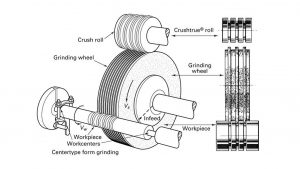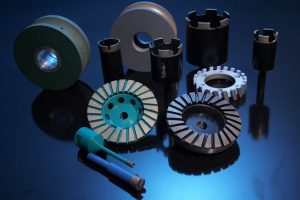Home / News & Blog / Abrasive Blog / Analysis of Factors Affecting Grinding Wheel Clogging
The main factors affecting grinding wheel clogging are as follows:

(1) Types of Abrasives
The degree of clogging varies significantly among different grinding wheels. To reduce clogging and improve grinding performance, different abrasive types should be selected based on the material of the workpiece. If the chosen abrasive cannot adapt to the grinding properties of the workpiece material, severe clogging may occur, making it impossible to carry out the machining process normally.
(2) Abrasive Grain Size
Abrasive grain size has a certain influence on grinding wheel clogging. Generally speaking, fine grains are more likely to cause clogging than coarse grains. When comparing the WA46ZR1 grinding wheel with the WA60K1 grinding wheel under the same conditions, the latter has a larger amount of clogging. However, when comparing WA20M and WA60M grinding wheels, after a certain number of cuts (125 times), the latter has a smaller amount of clogging. Because the pore volume and chip cross-sectional area of fine-grained grinding wheels are small, the number of cutting edges of fine-grained grinding wheels increases, and the number of chips is also large. In addition, the grinding temperature increases. Therefore, within the range of a small number of cuts, the number of chips in the pores of fine-grained grinding wheels, on the abrasive and binder, and the number of chip sintering products is large. As the number of cuts increases, the coarse-grained grinding wheel has a larger cut-in depth than the fine-grained grinding wheel, the wear of the abrasive cutting edge is greater, the grinding temperature rises, and the number of chip sintering products in the pores increases. After a certain number of times, the clogging amount of the coarse-grained grinding wheel will exceed that of the fine-grained grinding wheel.
(3) Grinding Wheel Hardness
The hardness of the grinding wheel greatly influences the amount of clogging. Generally speaking, the harder the grinding wheel, the greater the clogging. The hardness of the grinding wheel is generally GH. For some difficult-to-process materials, the hardness of DQ is also often used.

(4) Grinding Wheel Structure
The denser the structure of a grinding wheel, the greater the number of active abrasive grains and the shorter the distance between cutting edges, making clogging more likely. For example, grinding wheels containing 45% abrasive grains exhibit, on average, half the clogging compared to those with 49.2% abrasive grains. Conversely, grinding wheels with 53% abrasive grains show twice the average clogging compared to those with 49.2% abrasive grains.
When grinding materials that are prone to clogging and difficult to machine, it is generally recommended to use a grinding wheel structure grade of 7~8. Grinding wheels with large pores tend to perform better in such cases.
(5) Grinding Wheel Peripheral Speed
The effect of grinding wheel peripheral speed is quite complex. When the speed is increased from 28.8 m/s to 33.6 m/s, a 16% increase, the clogging amount triples. This occurs because the increased speed reduces the maximum cutting depth of the abrasive grains, decreases the chip cross-sectional area, and increases both the cutting frequency and grinding heat, all of which contribute to higher clogging. However, when the grinding wheel speed reaches a certain high level (e.g., above 50 m/s), the clogging amount significantly decreases.
Practical production experience shows that when grinding stainless steel and high-temperature alloys, grinding wheels operating at 55 m/s exhibit 30%~100% less clogging than those at 30 m/s. Therefore, when grinding difficult-to-machine materials, either speeds below 20 m/s or above 50 m/s should be used. Selecting a speed in between these ranges is highly disadvantageous for minimizing clogging. Naturally, for different workpiece materials, there is a specific critical grinding wheel speed at which the clogging is minimized.
(6) Radial Depth of Cut
The effect of radial depth of cut on grinding wheel clogging exhibits a hump-shaped trend. When the radial depth of the cut is small (ap < 0.01 mm), clogging occurs. As the depth of cut increases, the average clogging amount also rises. However, when the depth of the cut reaches a certain level (ap = 0.03 mm), the clogging amount begins to decrease. Beyond this point, as the depth of cut continues to increase (up to ap = 0.04 mm), the clogging amount sharply rises again.
When grinding difficult-to-machine materials, controlling and optimizing the final radial depth of cut is critical for improving the surface quality and precision of the workpiece. A common issue encountered during grinding is when a radial depth of cut of 0.005 mm is used for the final pass on stainless steel. In such cases, the grinding wheel often slips on the workpiece surface, failing to meet the desired specifications. Continuing to grind under these conditions can lead to surface damage or even render the workpiece unusable. However, when a radial depth of cut of 0.02 mm is used for the final pass, the surface roughness and precision of the workpiece often meet the requirements. This is primarily because the radial depth of cut has a significant impact on the grinding wheel’s performance.
(7) Table Speed
When the table speed decreases from 1.2 m/min to 0.5 m/min, the grinding wheel clogging increases by fivefold. At a table speed of 0.5 m/min, fine chips are produced, most of which become embedded in the pores. Conversely, at a speed of 1.2 m/min, long chips are generated, which only press into the larger pores.
Thus, under the same total grinding volume, the impact of table speed on grinding wheel clogging is as follows: the slower the table speed, the more frequently the abrasive grains engage with the workpiece, leading to higher surface temperatures on the workpiece and increased clogging.
(8) Grinding Wheel Dressing Speed
The purpose of dressing the grinding wheel is to remove the dull abrasive grains and expose new abrasive grains, while also creating new gaps. The dressing speed of the grinding wheel also has a significant effect on clogging. For example, the amount of clogging when the grinding wheel is dressed at a speed of 0.3m/min is 2 times greater than that when it is dressed at 0.6m/min, and the amount of clogging when it is dressed at a speed of 0.6m/min is 10 times greater than that when it is dressed at 1.22m/min. This is because when the dressing speed of the grinding wheel is low, the working surface of the grinding wheel is flat, and the number of effective grinding knives per unit area increases, which makes the cross-sectional area of the chips smaller and the number of chips increases, so clogging is more likely to occur. When the dressing speed of the grinding wheel is high, the working surface of the grinding wheel becomes coarser, the number of effective abrasive grains decreases, and concave portions appear on the surface of the grinding wheel, which act as pores; the chips are easily washed away, and the sintered materials are easily detached. Therefore, there is an optimal speed range for dressing various grinding wheels.
(9) Workpiece Speed
The influence of workpiece speed on the degree of grinding wheel clogging is closely related to other factors in cutting conditions. Under the given experimental conditions, the amount of grinding wheel clogging increases threefold when the workpiece linear speed is doubled. This is because the higher the workpiece speed, the shallower the abrasive cutting depth, and the smaller the chip cross-sectional area. This is equivalent to the hardening of the grinding wheel characteristics, so it is easy to cause grinding wheel clogging.
(10) Grinding Fluid
Different grinding fluids have a great influence on the grinding effect. The commonly used emulsions contain a large amount of mineral oil and oily additives. After dilution, they are water-in-oil milky white liquids. Their specific heat capacity and thermal conductivity are small. During the intense friction process, they can easily cause adhesive wear and diffusion wear between the grinding wheel and the workpiece, causing the grinding wheel to clog, the grinding force to increase, and finally causing the abrasive particles to break and fall off prematurely, reducing the grinding ratio. Therefore, the selection of excellent grinding fluids plays an important role in improving grinding performance. In recent years, some new grinding fluids have been developed for different grinding materials (see Chapter 5). Even so, excellent grinding fluids are still a major research direction for future grinding research.
(11) Grinding Method
Generally, plunge grinding results in more severe clogging than longitudinal grinding. This is because plunge grinding involves a larger contact area between the grinding wheel and the workpiece. Abrasive cutting edges repeatedly pass over the same grinding marks, and the difficulty in delivering grinding fluid to the grinding zone leads to higher heat generation, creating conditions conducive to clogging.
In longitudinal grinding, the edge of the grinding wheel makes the initial contact with the workpiece material, resulting in a smaller contact area. Grinding fluid can easily penetrate the grinding zone, and abrasive grain wear primarily occurs on the initially contacted edge. As the worn surface grows to a certain extent, the abrasive grains fracture and break under grinding forces, enabling self-sharpening.
Most abrasive grains remain sharp during operation, leading to lower grinding forces and heat. Additionally, a significant portion of the areas affected by grinding forces and heat is discharged out of the workpiece along the longitudinal grinding direction, reducing the likelihood of chemical adhesion. These combined factors make the clogging of grinding wheels less severe in longitudinal grinding compared to plunge grinding.